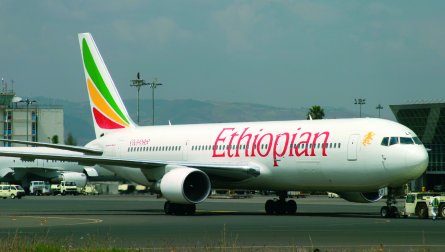Victoria Moores / Addia Ababa
The carrier is aiming to double its current $500 million turnover by 2010 by growing its airline activity, diversifying its service revenues and securing alliance membership. Following this strategic shift, services will account for half – rather than the current 20% – of Ethiopian’s revenues. Executive officer for corporate planning and development Kinfe Kahssaye says: “Over 15-20 years this airline has to become a very big airline.”
|
| Boeing 787s will soon join Ethiopian's 767 fleet |
Although competition in Africa is increasing, Kahssaye says that it is essentially an untapped market. But he predicts that in five to 10 years the continent – including Ethiopia – will be revitalised by new oil wealth. “That is going to give African countries the money to modernise their economies, increasing disposable income and creating a travel boom. In 10-20 years from now we will see a mega-boom in Africa,” he says.
Ethiopian is aiming to tap this development by forming a strong strategic co-operation with a western African carrier with an independent long-haul network. “We want that airline to be to the size of Ethiopian as soon as possible. It will have to grow fast. The potential is huge in west Africa,” he says.
The most likely candidate is Accra-based Ghana International Airlines (GIA), which began operations in October last year. But despite year-long negotiations towards securing a 20% stake, a firm deal has yet to emerge.
While Kahssaye remains confident of the GIA investment, he says that Ethiopian could alternatively seek a minority stake in a west African start-up where Ethiopian would take management control. He lists potential locations as Equatorial Guinea, Togo or Gambia.
The airline also plans to form a hub in southern Africa by teaming up with a regional carrier, which would benefit from a “strong feed” with Ethiopian’s hub at Addis Ababa. Kahssaye identifies Botswana and Zambia as “the most attractive” locations for this project.
Ethiopian will cater for the region’s traffic development by deploying a renewed fleet that will include Boeing 787s from 2008. Although currently focused on sourcing interim capacity, the airline is contemplating adding a further five examples to its 10-strong 787 order. Ethiopian will be the second operator of the 787, after Japan’s All Nippon Airways, in September 2008.
A review of Ethiopian’s domestic and regional operations is due for completion in June, generating a likely need for around 12 regional aircraft. But this plan could be thwarted by sub-standard airport infrastructure.
State-owned Ethiopian may ultimately progress towards privatisation, but it is not an immediate priority. Ethiopian Airlines chief executive Girma Wake says it benefits from “business-like and supportive” government relations, “without too much interference”. ■
Source: Airline Business
























